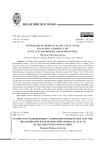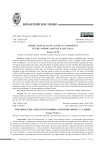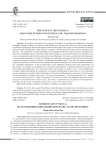Византийское право. Рубрика в журнале - Вестник ВолГУ. Серия: История. Регионоведение. Международные отношения

Статья научная
The author aims to summarize, analyze, and supplement the knowledge about the Slavic copy of the Byzantine Farmer’s Law in Ms. Slav 466 from Hilandar monastery, second quarter of the 15th century. It has long been in the focus of Serbian philology and history of law. The current observations refer to the following spheres: the relationship between text and manuscript, the axiological significance of precedential texts in culture, the importance of this copy for Byzantine-Slavic interactions in the legal system, the uninterrupted cultural role of Holly Mountain’s monasteries for Eastern Christian culture. The Slavic copy of the “Farmer’s Law” in Hil. 466 is unique by structure and peculiarities. The manuscript testifies to the only known combination of the Farmer’s Law and the Prochiron in the South Slavic tradition. It is hypothesized that this combination was a conscious choice of the compilers of the collection influenced by tendencies in the post-Byzantine tradition. It corresponded to the strong anti-heretical line of the overall manuscript, inherited from the struggles against heresies on Mount Athos in the 14th century. The manuscript is a typical monastic miscellany. The linguistic nature of the “Farmer‘s Law” copy reveals its undoubted South-Slavic character, without russification, strongly influenced from the Greek protograph. Copy and translation may probably be of close chronology. Owing to being a precedential text, the Slavonic copy of the “Farmer’s Law” in Ms. Slav. 466 holds a special place in the attempts of reconstructing the stages and processes of reception of the Byzantine juridical legacy among South Slavs, of establishing the geographic-areal scope and the cultural itineraries of the spread of this text.
Бесплатно

Three novellae of Alexius I Comnenus in the Nomocanon of Saint Sava
Статья научная
Chapter 46 of the Nomocanon of St. Sava was an important point in establishing the Christian model of marital and premarital relations in the newly founded Archbishopric of Žiča. Together with the rules laid down in Chapters 55, 56, 58, and 59, it was part of the mixed, canonical and secular materials regulating the topic. This paper presents and analyzes the content of Chapter 46, which contains a section with three laws promulgated by Byzantine emperor Alexius I Comnenus. The Novella of 1095 regulates the process of proving freedom for persons descended from “Bulgarians and the like” and introduces mandatory religious marriage, which the scholarship interprets as the full penetration of the Christian notion of grace into this sphere of life. The other two novellae (1084 and 1092) regulate lawful, “genuine” betrothal, per ecclesiastical and secular law. It was to precede marriage and required a religious ceremony of betrothal for persons of age. The Novella 1092 was enacted on the occasion of receiving an oikonomia from the previous requirements. These Novellae of Alexius I Comnenus were drawn up in response to the peculiar needs of the Byzantine state and society and the conflicting positions in this branch of law; they also directly led to the writing of numerous church treatises and polemics in Constantinople and the provinces. Some of those writings were included in the Nomocanon of St. Sava. Therefore, although grouped into a separate section, Alexius' novellae should be seen in the context of other rules on betrothal and marriage adopted upon the establishment of the autocephalous Serbian Church.
Бесплатно

Концепт "res publica"и его рецепция в византийском праве: транслитерации
Статья научная
Проблема рецепции понятия «res publica» сложна и многогранна. Нельзя сказать о том, что она применительно к периоду Средних веков досконально изучена. Задача автора - продемонстрировать с помощью экспертной системы «Византийское право и акты» возможности применения информационного подхода в сфере когнитивных изысканий к раскрытию содержания рецепций и латинско-греческих транслитераций понятия «res publica». Проделанные сопоставления с латинскими прототипами их греческих переводов и компиляций византийского права доказывают: компиляции вовсе не обязательно следовали своим прототипам в передаче понятия «res publica». Оно, как правило, замещалось иными греческими понятиями и словосочетаниями. Для них, как и их латинского прототипа, очевидна определенная семантическая неоднозначность. Сообразно тому у средневековых византийских юристов проявляется потребность к использованию прямой рецепции латинского понятия «res publica», в частности «rei publicae causa». Оно служило предметом внимания профессиональных правоведов, которые использовали указанный концепт для толкования и объяснения содержания источников средневекового византийского права. Заметные расхождения форм записи выявленных рецепций и греческих транслитераций понятия «res publica», вероятно, обусловлены индивидуальными особенностями средневековых византийских юристов и их профессиональной квалификацией. В большинстве случаев непосредственные заимствования понятия «res publica causa» или его транслитерации, выявленные в средневековых византийских памятниках права, носили сугубо терминологический характер. Его, если это допустимо, можно рассматривать в качестве некоего культурного феномена. Статья включает разделы: Введение, Рецепции и транслитерации, «Парафразы институций» Феофила Антецессора, «Василики», Схолии к «Василикам», Другие компиляции, Заключение, также два приложения: Приложение 1. Непосредственные рецепции и транслитерации понятия «res publica» и восходящей к нему терминологии и Приложение 2. Дистрибуция рецепций и транслитераций понятия «rei publicae causa».
Бесплатно

